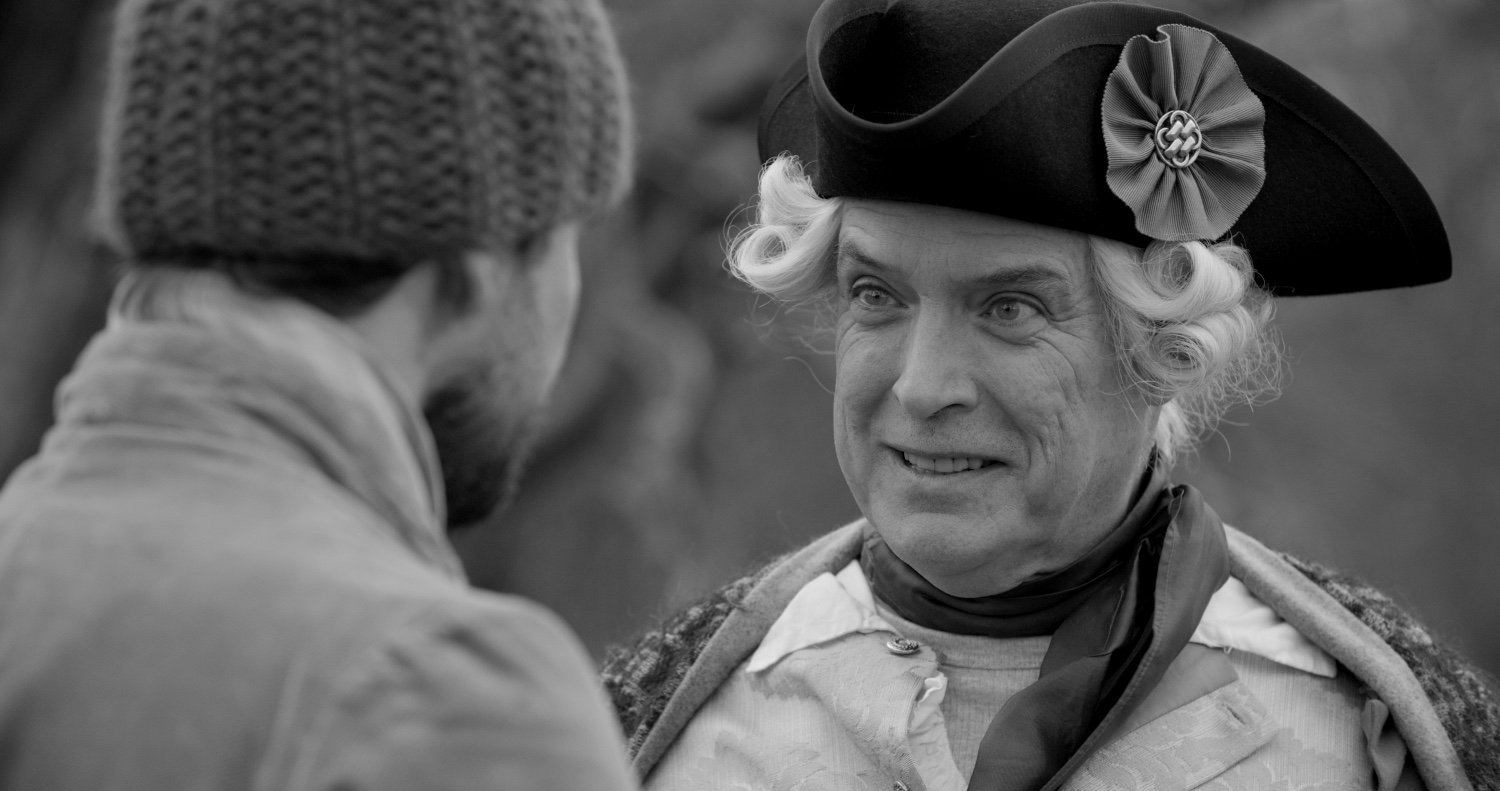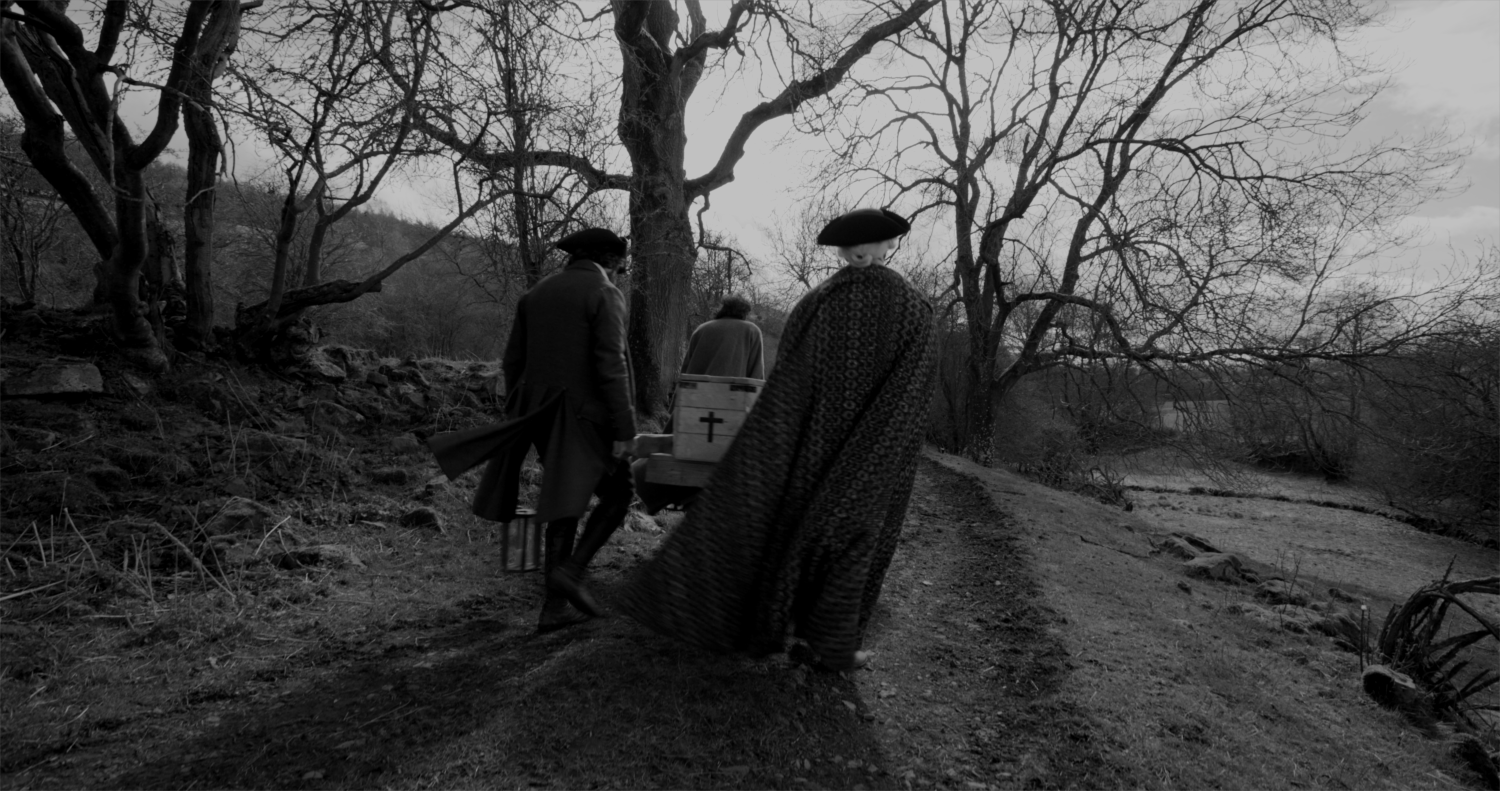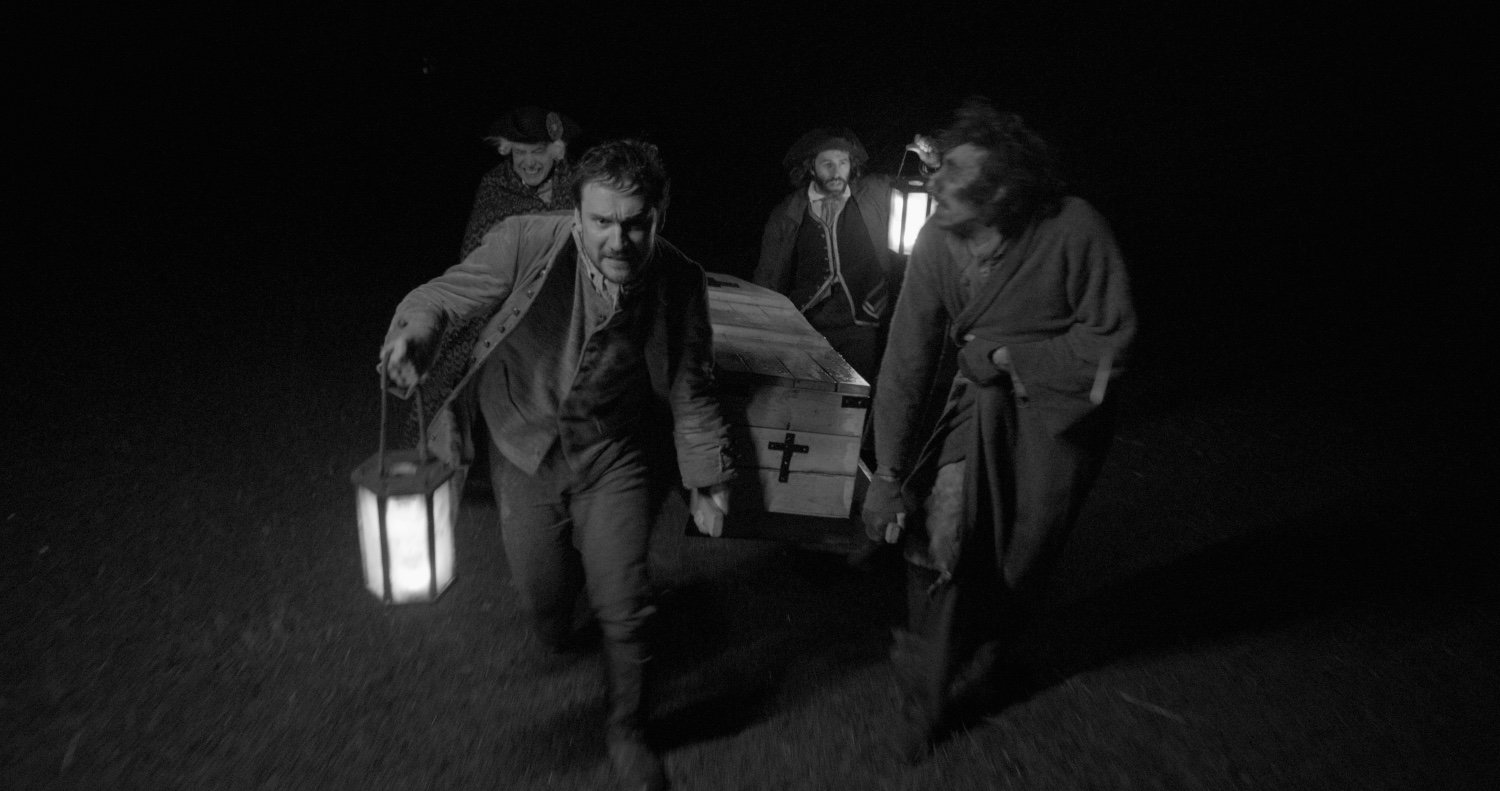If you’ve been creeping around Shudder looking for something to add a little fright to your seasonal viewing, you might have noticed The Haunted Season—a brand new anthology series from showrunner Kier-La Janisse, a genre expert whose many works include standout film-theory book House of Psychotic Women and recent folk-horror documentary Woodlands Dark and Days Bewitched.
The first entry, To Fire You Come at Last, is written and directed by Sean Hogan; it’s about a group of men carrying a coffin to be buried who’re haunted (literally) by past misdeeds while making the journey. To learn more about The Haunted Season, which will bring one new entry to Shudder over the next several years, we talked with Janisse over video chat.
Cheryl Eddy, io9: I have read your book Yuletide Terror: Christmas Horror on Film and Television, which gives a wonderful history of the genre and the traditions behind it. But for people who might not have read it, I’ll borrow one of the chapter titles and ask: “Why the ghost story at Christmas”?
Kier-La Janisse: It’s interesting because Derek Johnston, who wrote that chapter, years ago wrote a book called Haunted Seasons, which my title is completely ripped from [laughs]. When I was doing the Yuletide Terror book, there’s hundreds of films in it, but most of them are very obviously connected to Christmas in some way. They’re either about Christmas or they take place at Christmas, or there’s visible Christmas decorations so that you could justify it as a Christmas movie.
But a lot of the BBC’s A Ghost Story for Christmas [episodes] of the 1970s had nothing to do with Christmas. And so when I was including them in the book, I thought, North American audiences are not going to understand why these films are here because they’re like, “What do they have to do with Christmas?” I asked Derek if he would write a chapter talking about where this tradition comes from, of telling ghost stories of Christmas and the idea of Christmas programming—not necessarily the programming itself, but the fact that it’s chosen to be programmed at that time.
It goes back centuries—it comes from the older tradition of telling winter’s tales. [When] people gathered around the hearth or around the fire, and they would come up with entertainment to pass the time while they were trying to keep warm. Winter’s tales were what they were called because they’d be these spooky tales that they would tell [when] the days are so short and [the season is] turning over into a new year. There’s this idea of liminal boundaries between one state of being and another. They would tell these ghost stories and then over time, once we started having written literature, you would start to see references to them in [places like the works of] Shakespeare and Marlowe.
Then of course in the Victorian era, you have Charles Dickens’ A Christmas Carol, which was massively important, not only for the idea of the Christmas ghost story, but just for Christmas in general. It was part of Queen Victoria’s mandate to repopularize Christmas. Charles Dickens writing that story when he did was a big part of not only cementing this idea that Christmas is the time when we tell ghost stories, but that this is the time of year we have Christmas—because before Queen Victoria, it had kind of fallen out as a popular holiday. A Christmas Carol became important for creating a lot of these ideas and mythologies we have around Christmas—Christmas tree decorations and all these accouterments that we associate with Christmas that came from that period.
 © Shudder
© Shudder
The ghost story for Christmas came to be associated very strongly with that period—an also, there were so many ghost story writers in the Victorian era … there’s just tons and tons of them. And so when radio came in, they started doing radio adaptations of A Christmas Carol and other types of ghost stories around the holiday. Then, that transformed into television.
So the BBC was kind of always active and doing ghost stories for Christmas in some form or another. In the 1970s, Lawrence Gordon Clark, who was a director, proposed this idea of—he didn’t foresee it being a series. He proposed one film doing an adaptation of M.R. James’ story The Stalls of Barchester. He used a previous adaptation of an M.R. James story as proof that this could be popular; Jonathan Miller had made an adaptation called Whistle and I’ll Come to You in the late ‘60s, which is fantastic. And it was not made for Christmas. It was made for a different time of year, a different program.
But Lawrence Gordon Clark took that to them and said, “Look how good this is, and imagine if we could do something like this for Christmas.” So he made The Stalls of Barchester. It was a big hit, so then he got permission every year to keep making another one. And so it became a series; all through the ‘70s, there would be a different episode.
And so that is what my series The Haunted Season is based on—this idea of an annual ghost story film that premieres every year. And I know for North American audiences, using the word “series” to describe something that only has one episode for a year is weird, but it is based on that tradition. It’s basically a Christmas special that’s ongoing, where there’s a new installment every year. That tradition still exists in the UK. So this series is just part of that bigger tradition.
io9: How did you decide on To Fire You Come at Last as the first entry? How did writer-director Sean Hogan get involved?
Janisse: Sean Hogan is a filmmaker, a writer of books, a playwright—he does all kinds of all kinds of things. He’s incredibly talented, really great with period dialogue. And so I proposed to him—and he can do a lot with a little, which is important because we have very low budgets for these things—if he would make a short film originally for Severin Films’ folk horror box set. We were doing our new box set, All the Haunts Be Ours Volume Two. The first box set had my documentary [Woodlands Dark and Days Bewitched] on it—it had a new film on it. And we were like, “We don’t have an equivalent of that for the second box set.” So we asked Sean if he would make a film for that.
I gave him a couple of prompts for it. The idea of it being set on a corpse road was something that came from one of the prompts that I gave him.
 © Shudder
© Shudder
But before he even finished the film, I sort of flashed back to this idea that Sam Zimmerman from Shudder and I had over a decade ago when we used to work together for Fangoria magazine. Back then we were trying to get Fangoria to do a ghost story for Christmas that we could premiere on the website, and the publisher wouldn’t go for it. But we had wanted Sean Hogan to make that film.
So when Sean was making this film for me, before he was even done, I said to [Severin Films’] David Gregory, “What if we can pitch this to Shudder about being part of an ongoing series of ghost stories for Christmas?” And David was like, “Sure, go for it.”
And so Sam and I had a conversation, and it was amazing because it was this idea that we had that was not approved years and years ago. We were so excited about it, like, “Let’s do it now!” And so that was really how it happened. It was in some ways a very long-gestating project, but then it just was like everything clicked, where it was like, all of this could actually work, you know? I’m just super glad that Sean Hogan made the first one because he was the filmmaker we were talking about doing the Fangoria one all those years ago.
I love the film. It turned out so well. He made it with a small team in the UK and—you can’t tell from watching the film, but it was freezing and raining while they were making it. They were in very adverse conditions, but I think it turned out really well.
io9: To Fire You Come at Last is very traditional, very much in the style of the older films. Is that something we’ll be seeing as the series continues?
Janisse: I don’t know that they’ll be in black and white, but they will all be period. They won’t necessarily be that same period, but they are supposed to engage with the past in some way. The guidelines that I’ve given the filmmakers is that definitely nothing after, like, 1960. You can go back to the Middle Ages if you want, or you can go up to the ‘50s, you know, but it has to feel [like a period piece]. That was what the tradition always was.
It’s interesting, when A Ghost Story for Christmas first played in the ‘70s, the last two episodes, they made modern stories—they did not adapt like older Victorian ghost stories. They made new stories, modern stories set in modern settings. And the audience at the time revolted—a lot of them got bad reviews. Now people love those episodes because now they’re vintage, now they’re period pieces. But at the time when they were new, people were like, “You’re ruining the tradition!” So I decided that I was going to keep the parameters. It’s [a pretty broad time frame], but they will still be period pieces of some sort.
io9: Can you tease anything about any of the other entries?
Janisse: The only thing I can tease is that I’m doing one of them [as my first narrative film]. I have asked other people, they’re writing their scripts now—I’ll tease [more] when the time gets closer.
 © Shudder
© Shudder
io9: I am a big fan of Woodlands Dark and Days Bewitched, your folk horror documentary. Are these Christmas ghost stories part of the folk horror tradition?
Janisse: It definitely crosses over because of that oral tradition aspect of it. Like a lot of the BBC ghost stories for Christmas, you probably call them more like gothic horror than folklore, but it depends. Something like A Warning to the Curious and Whistle and I’ll Come to You you could call folklore because they’re definitely digging up an artifact from the past that is carrying all this baggage with it. There’s definitely folk horror elements to some of them, but some of them are definitely more in the gothic realm. But I think that Christmas ghost stories, just because of the fact that they’re tied to this oral tradition, that makes it a bit more connected to folklore.
io9: And you’ve mentioned a couple of titles, but for people who watch the first episode of The Haunted Season and want to see more in that vein, what do you recommend they seek out?
Janisse: Well, Shudder has licensed Jonathan Miller’s Whistle and I’ll Come to You. Absolutely start with that. And they’ve licensed Lawrence Gordon Clark’s A Ghost Story for Christmas from the 1970s. Those are the ones that my series is referencing, so I would recommend taking in all of those—there’s like nine different choices of what they can watch. I don’t know if they have The Stone Tape on Shudder [editor’s note: they do!] but The Stone Tape was broadcast for Christmas. It doesn’t have anything to do with Christmas, but it was broadcast as part of the Christmas programing, as a Christmas ghost story. And that’s a great one, too.
Watch To Fire You Come at Last, the first episode of The Haunted Season, on Shudder now.
Want more io9 news? Check out when to expect the latest Marvel, Star Wars, and Star Trek releases, what’s next for the DC Universe on film and TV, and everything you need to know about the future of Doctor Who.
